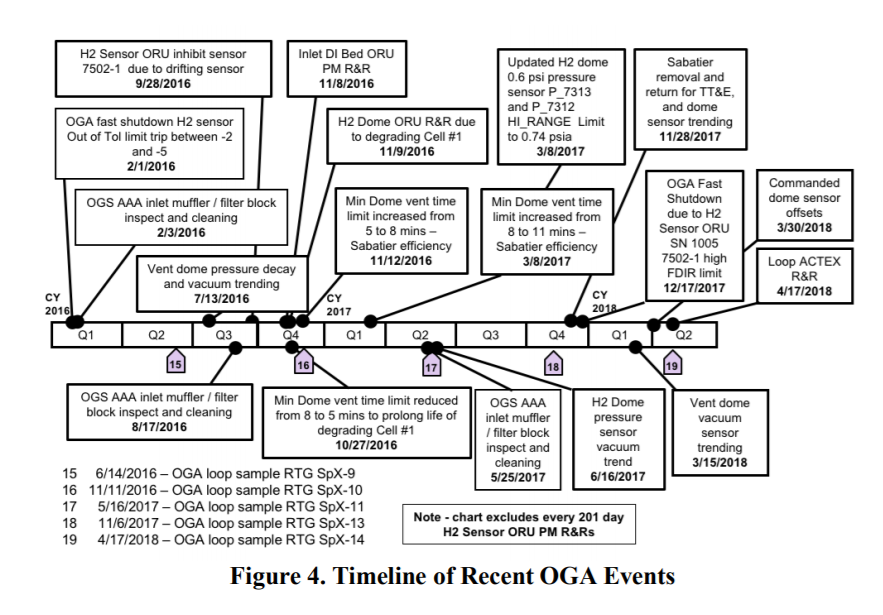Figure 4. Timeline of Recent OGA Events
 The timeline say the Sabatier was removed and returned at 11/28/2017 for TT&E.
The timeline say the Sabatier was removed and returned at 11/28/2017 for TT&E.
2019 - Advanced Oxygen Generation Assembly for Exploration Missions - Kevin Takada et al
source
This below is what I was able to find, with more detailed information.
The performance of the Sabatier reactor degraded over the last several years and was removed from service in October 2017 and returned to ground for a failure investigation. The ISS Program Office is currently planning to build another Sabatier reactor for operation on ISS in 2020.
source
11/28/2017 Crew Removing the Sabatier unit from the Oxygen Generation System (OGS) Rack. From on-orbit report
01/27/2017 Sabatier Restart: Last month, the Sabatier system could not be restarted after being in Standby for an extended period of time. During the attempted restarts, the system showed little to no reaction occurring in the reactor and no water being produced. Yesterday, ground teams executed a procedure to warm up the reactor prior to a restart attempt and successfully restarted the Sabatier. The team believes that the higher temperature and additional duration of the heat soak allowed the reaction to kick off. Water continued to be produced overnight. From on-orbit report
Another failure reported, from 2013: (...)The original failure was due to delta pressure fault detected at the inlet to the reactor assembly. The second attempt was unsuccessful when liquid water was detected on both liquid sensors on the Sabatier vent line. After allowing the liquid sensors to dry out, the ground performed a third attempt which was successful. Sabatier was operational overnight before faulting out and shutting down once again. This last shutdown was due to another delta pressure fault. The fault signatures are indicative of moisture in the CO2 accumulator which is partially blocking flow. Sabatier team is concerned with moisture being received from Carbon Dioxide Removal Assembly (CDRA) or condensation that has accumulated in the CO2 accumulator tanks. on-orbit report
I didn't get more details about the failures. It is interesting that the link you used in your question says at the end "Last updated: 7 August 2017". But it seems that it was not, because even the return to TT&E the link/text does not mention. Just 2 months before, they could to add it info.
More info about the subject:
A Sabatier reaction based CO2 Reduction Assembly (CRA) is a hardware that interfaces with the Oxygen Generation Assembly (OGA) and Carbon Dioxide Removal Assembly (CDRA), using the Carbon dioxide available from CDRA and the hydrogen that is available from OGA water electrolysisis. When CRA is activated it produces methane and water via the Sabatier reaction
CO2 + 4H2 <-> CH4 + 2H2O
source
All of that components are part of the ISS Environmental Control and Life Support System (ECLSS)
